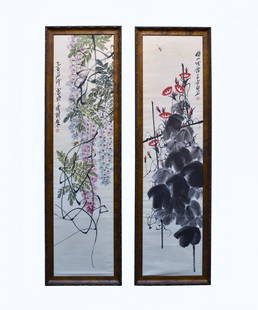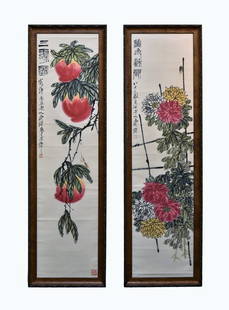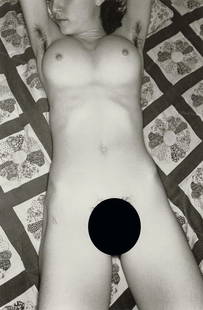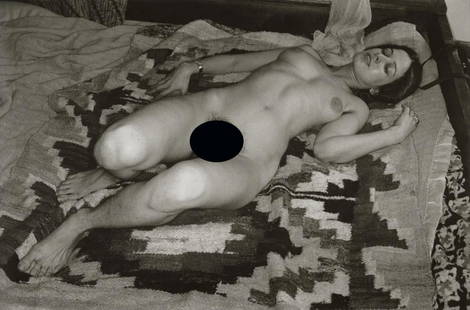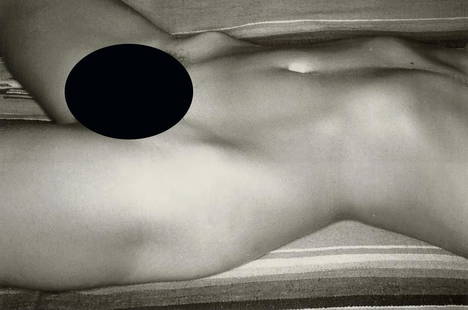
The Edward Harriman Twenty-Volume Set from Edwar
Similar Sale History
View More Items in PaintingsRelated Paintings
More Items in Paintings
View MoreRecommended Art
View More



Item Details
Description
"I like a man who attempts the impossible." - J. P. Morgan, legendary financier and philanthropist, and principal patron of The North American Indian
"In Mr. Curtis we have an artist and a trained observer, whose pictures are pictures, not merely photographs; whose work has far more than mere accuracy, because it is truthful... Mr. Curtis in publishing this book is rendering a real and great service; a service not only to our own people, but to the world." - President Theodore Roosevelt
This represents the final compilation of decades of field photography and research by Edward S. Curtis (1868 - 1952) who labored under Morgan's patronage for twenty-three years, from 1907 - 1930, to complete the series. Picturing and describing in unprecedented detail the Native Americans of the Western United States and Alaska, these volumes include some 1511 hand-printed illustrations (including 1505 photogravures, four maps, and two diagrams), as well as over 3000 pages of text and translations of languages and music.
The Set consists of twenty Volumes: Text, Quarto (313 x 239 mm), in publisher's original brown half morocco, gilt and buckram, top edges gilt, others uncut, stamp-signed by H. Blackwell, master bookbinder. Each volume is numbered 308 on verso of the half-title page, and is housed in an elegant custom-made slipcase.
It is difficult to fully envision the scope of Curtis's project. Its cost has been estimated, in dollars adjusted for inflation, at $30,000,000 - $35,000,000. According to noted author and critic A.D. Coleman, the result is "an absolutely unmatched masterpiece of visual anthropology, and is one of the most thorough, extensive, and profound photographic works of all time." (Sacred Legacy: Edward S. Curtis and the North American Indian, ed. Christopher Cardozo, NY, 2000, page 25). These volumes constitute one of the most comprehensive ethnographic records ever accomplished, as well as one of the most ambitious undertakings in fine book making.
"Never before have we seen the Indians of North America so close to the origins of their humanity, their sense of themselves in the world, their innate dignity and self-possessions." - N. Scott Momaday, Pulitzer Prize-winning Native American author
Originally an edition of 500 sets was proposed, but only 214 sets were subscribed to, and another sixty were compiled and sold later. The set offered here belonged to fabulously wealthy railroad magnate Edward Harriman, another of Curtis's patrons. It was Harriman who financed the 1899 Alaska expedition for which Curtis served as the original photographer, and which would provide the inspiration and impetus for Curtis's magnum opus, The North American Indian. Volume I is signed by Curtis and dated 1907, the year the first volume appeared with an introduction by President Theodore Roosevelt. Harriman's set is of the highest quality available, printed on India Proof Paper ("tissue") tipped in, and Dutch Van Gelder Paper. Only an estimated fifteen of the original subscriber sets were printed on tissue, including Curtis's personal set and those of J. P Morgan and the King of England. Roosevelt, Morgan, and Curtis's sets are all ensconced in institutional collections. Only Harriman's remains available for private ownership.
EDWARD S. CURTIS
"It's such a big dream, I can't see it all." - Edward S. Curtis
Curtis is perhaps the most widely collected and exhibited fine art photographer in the 170-year history of the medium. His work has been exhibited in over forty countries, and is found in thousands of private and public collections including those of the Getty Museum, Museum of Modern Art, Metropolitan Museum, and The Museum of Modern Art.
Edward Curtis grew up in poverty and his formal education ended with the sixth grade. He was largely self-taught in photography, but would go on to win numerous awards and become the friend and associate of presidents, kings, titans of business and industry, and important tribal leaders throughout the Western United States and Canada. His three-decade commitment to The North American Indian left Curtis a broken man. His health, finances, and family were all sacrificed in his single-minded pursuit of his dream, but he left a sacred legacy which will endure for generations to come. Curtis would no doubt be stunned and gratified to know that sets of his twenty volumes and twenty supplementary portfolios consistently command prices well into seven figures from collectors and institutional buyers. In the end, this valuation by the marketplace constitutes a meaningful judgment on the merits of his life's work.
EDWARD H. HARRIMAN AND EDWARD S. CURTIS
"Much good work is lost for want of a little more." - Edward H. Harriman
Harriman (1848 - 1909) rose from humble beginnings to become one of the five wealthiest men in the world. A grade-school drop-out, he enjoyed a meteoric rise on Wall Street before turning his energies to railroads at the age of thirty-three. He has been designated one of history's twenty most important business leaders by Forbes magazine. His son Averell would become an ambassador, cabinet member, and governor of New York, and during the 1950s was a serious aspirant to the Democratic Party's nomination for president of the United States. Upon Edward's death, his wife Mary, sole heir to his vast estate, would become an active philanthropist. The Harriman Curtis Set was in her custody until, upon her death, the volumes passed to the Mary W. Harriman Foundation. The twenty loose supplementary portfolios of photos which accompanied the twenty volume set were dispersed over the years, but the Volumes remained intact until purchased by the present owner from the Foundation in 1999.
In 1899 Edward Harriman organized and financed the largest and most famous scientific expedition the world had ever seen, the Harriman Alaska Expedition. Scientists made over 600 important discoveries during the expedition, and created an invaluable survey and assessment of Alaska in the days of the Klondike Gold Rush, when the Territory was going through major transition. The project would lend impetus to the nascent movement to preserve America's wilderness, a movement spearheaded by Harriman Expedition member John Muir, and soon after by Curtis's greatest champion Theodore Roosevelt.
Curtis was named the official photographer of the Expedition, on which he met and worked with many of the great scientific luminaries of the day. One of these was George Bird Grinnell, with whom Curtis went to live in Montana the following year to photograph the Blackfeet and Piegan. It was the watershed moment in Curtis's professional life, and launched him on his thirty year mission to create The North American Indian. Without his seminal experiences on the Harriman Alaska Expedition, it is doubtful that Curtis would ever have envisioned or created his masterwork.
THE HARRIMAN SET
In any category of art or collectibles, condition is of paramount importance. This is particularly so with fine photography and rare books, where condition issues can seriously impair one's visual appreciation of the work. In that regard, the Harriman Set is a standout example, surely one of the most original and best-preserved tissue sets which have survived. The bindings are fresh and bright, and the details remain warm and lustrous. The interior pages are equally exceptional, showing only a soft, light patina of age. Indeed, the volumes have a feel of having been opened rarely, if at all.
Together with the supporting materials described below, the Harriman Set, in remarkable condition and with historic provenance, is almost certainly the finest stand-alone set of volumes in private hands, and is offered here on the open market for the first time.
ACCOMPANYING PRINT, BOOK, AND EPHEMERA COLLECTION
As a lifelong scholar and collector of all things Curtis, the consignor has over several decades accumulated an extensive collection of related material. Given the important provenance of the Harriman Set, the consignor has decided to include with this offering a grouping of fifty-three items which would be impossible to duplicate, including a highly desirable full sheet photographic self-portrait of Curtis, a possibly unique platinum photo of Harriman by the master, and a wide variety of ephemera related to the Harriman Alaska Expedition and The North American Indian. A complete inventory of this supplementary archive, which has significant stand-alone value in itself, can be found below.
ABOUT THE CONSIGNOR
Christopher Cardozo is widely regarded as one of the leading authorities on Edward S. Curtis. His personal collection, 39 years in the making, is almost certainly the most extensive Curtis collection ever assembled. Cardozo is the author of eight monographs on Curtis, and has created and curated one-person Curtis exhibitions that have been seen in nearly 100 venues in over forty countries on every continent except Antarctica.
"No individual, other than Curtis himself, has done more for the increased awareness of Edward S. Curtis and his marvelous photographs." (Bullfinch Press, 2005).
Cardozo first discovered the work of Edward Curtis in 1973, when a friend who was inspecting Cardozo's own sepia-toned photographs of Native people pointed out the similarity to Curtis's work. Cardozo had just spent six months living in an isolated tribal village where he had shot over 10,000 negatives, created film footage, made sound recordings of language and music, and collected traditional clothing, utilitarian objects, etc. He immediately developed a deep affinity for Curtis's work, and began a forty year odyssey of scholarship and collecting. His personal collection has been exhibited in major museums in Switzerland, Germany, Spain, Italy, and Paris (to record-breaking attendance). A major international tour is planned for the collection in 2014-2015, and Cardozo is immersed in putting together what will be the definitive reference book on Curtis's work.
Christopher Cardozo holds a BFA (Phi Beta Kappa and summa cum laude) in photography and film, and is a widely exhibited photographer in his own right. He also hold a Juris Doctor degree and has lectured on financial and legal aspects of owning works of art. His own photographs may found in many public and private collections including the permanent collection of New York's Museum of Modern Art. He was the youngest person in the 100-year history of the Minneapolis Museum of Art to have a one-person show, and his photographs of indigenous people have been widely collected and exhibited. His background as a fine art photographer and emotional connection to Native People have allowed him to fully appreciate the power and beauty of Curtis's work, and he is widely respected in the collecting world for introducing an unprecedented level of scholarship and connoisseurship.
Cardozo has also lectured internationally on the subject of Edward Curtis, and has been a frequent consultant to major auction houses and appraisers, as well as significant museums including the Morgan Library and Museum. His counsel has been sought in building many of the country's leading private collections. His personal collection was the subject of the widelyheralded monograph: Sacred Legacy: Edward S. Curtis and the North American Indian and the award-winning Native Nations. Cardozo's books have been translated into five languages, and over 300,000 copies are in print.
Cardozo has also been active in philanthropy, supporting many American Indian causes and non-profits, as well as arts and environmental organizations, for over three decades. He is the Founder and Board Chair of the Edward S. Curtis Foundation, which is dedicated to preserving and exhibiting the photographer's work. It is currently developing new exhibition models and avenues for education which will bring a new awareness and appreciation of the beauty, heart, and spirit of Curtis's Sacred Legacy to a worldwide audience.
He considers the Harriman Collection to be the "crown jewel" of his personal collection, and hopes that its sale will help generate funds which will help further his personal goals and those of the Foundation.
"The twenty Volumes are truly the 'heart and soul' of The North American Indian. While one can develop a great appreciation of Curtis' photographic skills from the images in the supplementary portfolios, it is only through the Volumes that one can understand the full scope of this 23-year project. While the volumes contain over 2/3 of the photographic images, (including many rarely or never reproduced elsewhere), it is only in the thousands of pages of anthropological text and transcriptions of language and music that one can comprehend the audaciousness of his dream and the depth and breadth of his scholarship. The North American Indian not only strives to document Native Americans on film, but to capture for all time their vanishing way of life."
Christopher Cardozo
SOME REFLECTIONS ON EDWARD S. CURTIS AND THIS REMARKABLE OFFERING
Over my eight years as head of the Americana department at Heritage I have been privileged to help bring to market a number of important objects which exhibited to varying degrees qualities such as historical significance, rarity, intrinsic appeal, exceptional condition, provenance, and investment value. But only rarely are we able to offer something which has them all. No item we have offered in the Historical area has more completely exhibited all these qualities than the Harriman set.
Edward Curtis's compelling portraits and artfully composed landscapes and still lifes are not simply ethnographic records, but are works of art which rise to the level of the very best photographers in any category. Clearly this has come to be recognized in a way which manifests itself in the marketplace. In recent decades photography has been one of the "hot" areas in the art world, with photographic works receiving high recognition in major museums and achieving stratospheric prices at auction. Edward Curtis is clearly poised to take his place in a pantheon which includes Ansel Adams, Carlton Watkins, and other masters of the medium. Rumblings in the marketplace began in 1993, when a set of The North American Indian set the world record for a photographic lot at auction, selling at Sotheby's for exactly one thousand times what it had fetched at the same auction house forty years earlier. Several years ago a major museum purchased a set of the 20 Curtis volumes and 20 portfolios for a price reliably reported to be approximately $2 million dollars. In April 2012 a major New York auction house sold a similar set in exceptional condition for a record price of $2,882,500. Perhaps even more tellingly, in October of this year a set with a variety of condition issues made $1,444,000 in another New York auction, setting an all-time single lot price record for that firm. Beginning in 2006, a number of individual Curtis prints have sold for over $100,000 each at auction. Clearly, something is up.
If one aspires to own an example of Curtis's masterwork, one could make no finer choice than the set presented here. The bound set encompasses over 1500 photogravures and over 3000 pages of hand letterpress printed text. This example is printed on the most expensive stock, and is in virtually unimprovable condition, having a subtle patina of age, but no more. With the Theodore Roosevelt and J.P. Morgan's sets permanently ensconced in institutional collections, the Harriman set carries the most important provenance of any set ever likely to be available for purchase. In addition, it is accompanied by a significant supporting collection of related items, assembled painstakingly over decades, including a rare and possibly unique Curtis studio portrait of Harriman and a stellar example of Curtis's iconic self-portrait, itself now commanding a five-figure price.
In the economic climate of the last five years fine art and collectibles markets have experienced significant adjustments. But one trend which has been seen across the boards is a steadily rising demand for the very best in any category. Collectors, institutions, and investors alike would do well to recognize the exceptional opportunity presented by this appearance of the Edward Harriman collection at auction.
Tom Slater
Buyer's Premium
- 19.5% up to $50,000.00
- 19.5% up to $1,000,000.00
- 19.5% above $1,000,000.00
The Edward Harriman Twenty-Volume Set from Edwar
Shipping & Pickup Options
Item located in Dallas, TX, usPayment






























